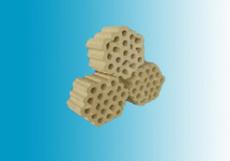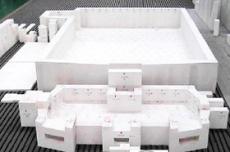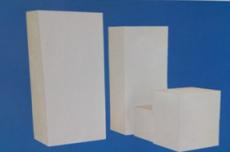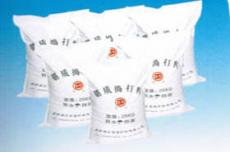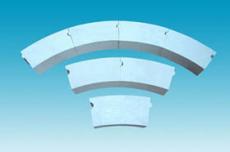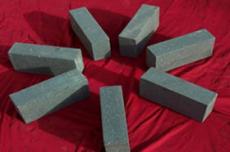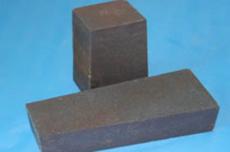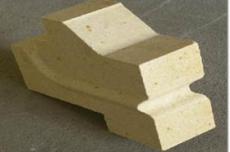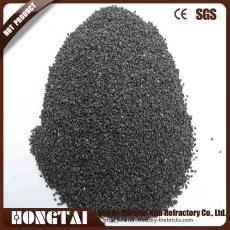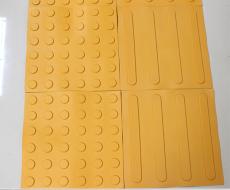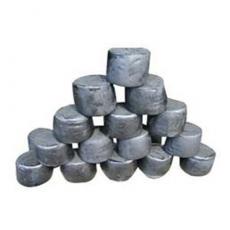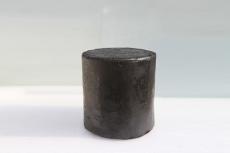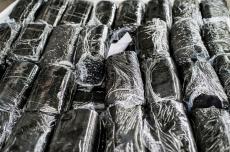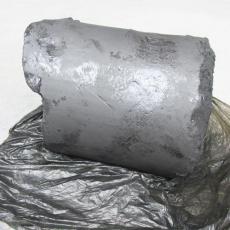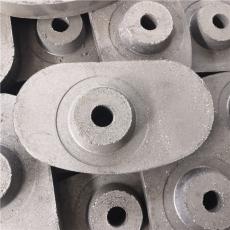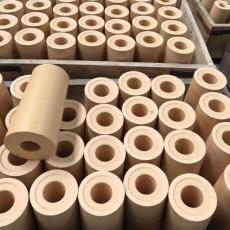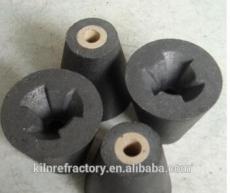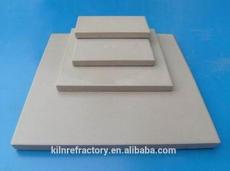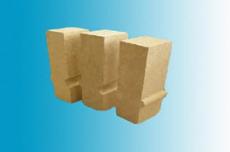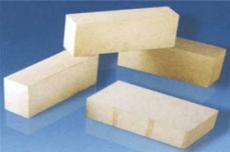
Nickel-iron furnace lining design
At present, the mainstream production of ferronickel from laterite nickel ores uses the RKEF process. Submerged arc furnaces are generally large electric furnaces above 33MVA. The core equipment of the RKEF process is submerged arc furnaces and rotary kilns. The design of submerged arc furnaces must first determine reasonable parameters: furnace shell diameter. , furnace shell height, furnace diameter, furnace depth, electrode diameter, etc. (the length, width, and height of a rectangular electric furnace are determined), and the determination of these parameters is closely related to the determination of the furnace lining parameters. Based on more than 10 years of experience in the operation of nickel-iron ore furnaces in China, generally speaking, a furnace bottom thickness of 2.0~2.2m and a furnace wall thickness of 1.0~1.3m can fully meet production needs and achieve stable operation of the furnace lining; some domestic The manufacturer chooses a deeper furnace bottom and thicker furnace wall than this data, which has no obvious advantages in actual operation and cannot effectively improve the service life of the furnace lining. Specifically, the appropriate furnace lining plan can be determined from the following aspects of design.
01Design of taphole and slag taphole
Both the taphole and the slag outlet use copper water jackets, which is beneficial to stable operation and maintenance during the production process. The depth of the tap hole is about 1.5m, the depth of the slag hole is about 1.3m, the diameter of the iron eye is 60mm, and the diameter of the slag eye is 100mm, which can effectively meet the production needs. There are 3~4 tap holes and 2 slag holes. The height difference between the slag holes and the iron holes is 600~800mm. It is recommended to be no less than 600mm. If the height difference is less than 600mm, molten iron is very likely to overflow from the slag holes during production, which will reduce the recovery rate of nickel. In severe cases, it may cause the slag to explode, posing a greater safety hazard.
02Selection of refractory materials
Nickel molten iron has a large specific proportion, high temperature, and strong permeability. If carbon bricks or magnesia bricks are used to build the furnace bottom in the early stage, the furnace bottom will burn through in a short period of time. The use of magnesia ramming material to knot the seamless furnace bottom effectively prevents molten iron from penetrating the furnace bottom and greatly increases the service life of the furnace lining. The furnace wall slag line uses 97 and 95 magnesia bricks, which can withstand high-temperature slag erosion during the smelting process. The overall structure of the furnace lining can be stabilized through slag hanging operations. Above the slag line, 75 high alumina bricks can be used as the insulation layer.
03Elastic layer and expansion joint settings
Generally, the current large-scale ferronickel electric furnace has a diameter of more than 17m, and the weight of the furnace lining refractory exceeds 2000t. During production, the weight of high-temperature molten iron, slag, and charge is about 1200~1600t. The furnace lining will bear great pressure and the refractory material will gradually expand as the temperature increases. Therefore, it is necessary to design a reasonable elastic layer to balance the pressure and expansion stress to prevent the furnace shell from being squeezed and cracked due to excessive stress, which will cause the furnace lining structure to become unstable and reduce the furnace lining life. Through theoretical calculations and actual empirical data, the elastic layer thickness of large electric furnaces is about 300mm, which is more reasonable. During the opening process of the brick furnace lining, a certain expansion will occur when the temperature rises from normal temperature to a high temperature of about 1600°C. According to the expansion coefficient provided by the manufacturer, 1mm auxiliary expansion paper needs to be left between bricks to eliminate the expansion stress. The overall stable effect of the furnace lining.
Furnace lining masonry construction
Good design is the basis for ensuring the service life of the furnace lining, and the quality of masonry construction is the key to ensuring the service life of the furnace lining. Construction is a complex and comprehensive project. Quality assurance in the production process of magnesia refractory materials is a prerequisite for ensuring the quality of furnace linings. Waterproofing must be done during transportation and construction. All refractory materials need to be sampled for physical and chemical index and strength data analysis before construction.
01 Preparation before construction
For the acceptance of the furnace steel structure, according to the design drawing, measure the furnace shell diameter and furnace shell height, calibrate the furnace core and center line, determine the center and position of the slag and iron eyes, and calibrate the height and other data. The thickness of the furnace shell steel plate is about 30mm, and the amount of welding is large. Each weld should be tested by UT to meet the design requirements. Only after the openings for temperature measurement points on the furnace bottom and furnace wall have been set, can the refractory masonry construction be carried out.
02Construction of furnace bottom ramming material
Put the ramming material into the furnace. The magnesia ramming material at the bottom of the furnace should be rammed in layers. The thickness of each layer of ramming material is about 160~200mm. Put the ramming material into the furnace according to the design requirements. After unloading the material, use a shovel or rake to level it, and then use an aluminum alloy long ruler and a level to level it. Then spread colored strips of cloth (canvas) on the smoothed ramming material. The colored cloth covers all the ramming materials at the bottom of the furnace, and the flat vibrator is placed on the colored cloth (canvas). The vibrators of each operation must maintain a certain distance, balance, and symmetry.
(1) Vibration. Start the vibrator. After the vibrator starts, it starts to vibrate from the outer ring, and pound from the outside to the inside (center of the furnace) one after another. The last circle should overlap one-third of the previous circle to prevent missing beats. Vibrate continuously from the inside of the furnace shell to the center of the furnace. After the first pounding is completed, pound it several times from the outside to the inside. Each layer of ramming material is pounded multiple times at the same time with two or more vibrators.
(2) Nail rake "pulling hair". After each layer of ramming, remove the dust-proof colored cloth (canvas), use a homemade rake to pull the hair on the surface of the ramming material layer in the same direction, and comb it into grooves to facilitate increasing the contact area of the upper and lower adjacent layers to form Seamless integral rammed furnace bottom.
(3) Knotting quality. The density of the compacted ramming material should be above 2.8g/cm3. At this time, the vibrator jumps up and down, the amplitude is larger, and the vibration sound is louder than the previous times. These phenomena indicate that the material layer is basically solid. Knotting quality inspection method: Use an iron rod with a diameter of 4mm, for example, the insertion depth of a 4mm welding rod shall not exceed 20mm. The vertical strength of the iron rod is 5kg.
(4) Precautions. When adding ramming material into the furnace, the ramming material in tons of bags should be added evenly into the furnace in several directions to facilitate manual smoothing of the ramming material and even feeding of particles. Pick out plastics, silk bags, and strings at any time, and strictly prohibit slag, iron blocks and other debris from being mixed into the material. During vibration operation, the vibrator should move forward slowly and at a constant speed, and the vibration should be balanced and steady to ensure the strength of the knot.
03 Furnace lining brick masonry
(1) Find the center of the furnace bottom, draw the lining circle boundary according to the inner diameter of the furnace lining, and build the lining magnesium bricks according to the lining boundary. After the lining ring bricks are built to a certain height, the elastic layer between the outer ring of magnesia bricks and the furnace shell can be filled with ramming material (no need to ram tightly).
(2) The bricks used to build the wall should be straight bricks and wedge-shaped bricks, and the circular joints should be filled with refractory powder and chiseled. When laying bricks, a wooden hammer or rubber hammer should be used for alignment, and an iron hammer should not be used. The closing bricks of the furnace wall should be evenly distributed on both sides at an angle of 90° to the taphole slag mouth.
(3) If the last door brick of each layer needs to be cut and processed, the brick must be at least half the width of the original brick, and the brick above the processed brick must be a whole brick.
(4) Each ring of bricks uses wedge-shaped bricks of different sizes according to their different diameters. When laying bricks, the center line of each brick should point to the center of the circle.
(5) The furnace lining above the slag line is filled with high alumina bricks and high alumina fine powder. The maximum joint thickness is 2mm, and the elastic layer between the bricks and the furnace shell can be filled with ramming material.
04Iron eye and slag eye masonry
(1) Before masonry, check whether the taphole and slag taphole bricks are complete.
(2) Pre-lay the tap hole and slag hole bricks, and polish and repair the unqualified parts.
(3) Do not use expansion joint paper in the area where refractory mud is applied to the left and right sides of the tap hole and slag outlet. The front and rear bricks must be staggered and there must be no through joints. The brick joints should be ≤1mm.
(4) The taphole and slag outlet bricks must be wet-layed with refractory slurry prepared from magnesium powder and water glass. When laying, the bricks built later must be tightly packed with the bricks built first. The brick joints should be filled fully with mud and no gaps should be left to prevent the penetration of molten iron.
